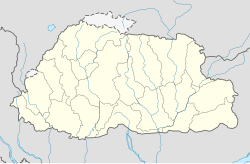Tang Valley is one of the four valleys of Bumthang District, Bhutan. [1]
Contents
Tang Valley | |
|---|---|
| Coordinates: 27°45′8″N90°40′40″E / 27.75222°N 90.67778°E | |
| Area | |
• Total | 1,320 km2 (511 sq mi) |
| Elevation | 2,800–5,000 m (9,200–16,400 ft) |
| Population | |
• Total | 1,816 |
| Time zone | UTC+6 (Bhutan Time) |
It is located 11 km away from Jakar, the administrative center of Bumthang District, Bhutan. It trails higher up the lake called Mebartsho. [2]
